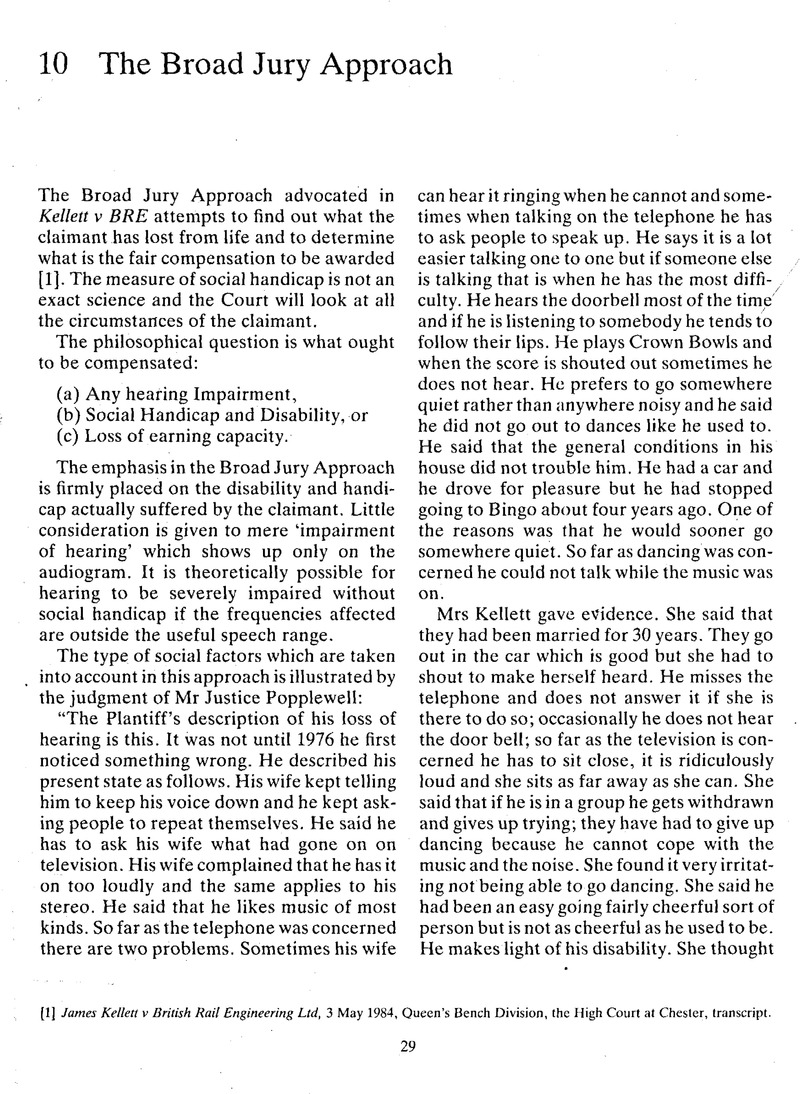No CrossRef data available.
Article contents
10 The Broad Jury Approach
Published online by Cambridge University Press: 09 November 2023
Abstract

- Type
- Other
- Information
- The Journal of Laryngology & Otology , Volume 100 , Issue S11: Forensic Audiology , 1986 , pp. 29 - 32
- Copyright
- Copyright © JLO (1984) Limited 1986
References
[1] James Kellett v British Rail Engineering Ltd, 3 May 1984, Queen's Bench Division, the High Court at Chester, transcript.
[2] Questionnaire for Loss of Hearing, from I.S. Goldrein, Personal Injury Litigation Practice and Precedents, Butterworths, 1985.
- 1.
1. Is there tinnitus? (the word denotes a continuous unusually high pitched noise appearing to originate from the inside of the head. It is notorious that this can be amongst the most distressing of ailments. It can have very serious psychological effects leading to nervous disorders). If yes, when did it start, to what degree, what does it sound like and how does it affect him? Is it bearable? Does it interfere with sleep?
- 2.
2. Is the deafness total or partial? If partial, is there a frequency above and/or below which he had total deafness? If yes, what are the material frequency or frequencies?
- 3.
3. In respect of each ear, what is the decibel hearing loss?
- 4.
4. Does he wear a hearing aid? If yes — when did he commence using it and what difference does it make? If not, why not?
- 5.
5. Can he hear radio and/or television and/or a film track at the cinema? If yes—with what degree of ease?
- 6.
6. With and without a hearing aid, can he distinguish what is being said when two or three people are talking at the same time?
- 7.
7. Is there buzzing in his ears when concentrating on listening, eg to music?
- 8.
8. Does he have difficulty conversing against background noise—especially at meetings or en the telephone?
- 9.
9. Has he learnt to lip read? If yes—when and how well? If not—why not?
- 10.
10. Can he hear the doorbell, telephone bell, bird song, etc?
- 11.
11. How often did he go out socially before the accident, and how often after?
- 12.
12. Can he appreciate stereo music?
- 13.
13. How does he manage in an ordinary two way conversation—and—ordinary three way conversation?
- 14.
14. What is the effect on his personality?
- 15.
15. Does he have any difficulty in particular in hearing a female as opposed to a male voice, or a child's voice as opposed to that of an adult?
- 16.
16. Prognosis?
- 17.
17. Prior to the injury did he associate with numbers of people, as for example in clubs or public houses? If yes—does he still (and if not, why not?)
- 18.
18. When did he start to be aware of his deafness? What put him on notice? How gradual was the deterioration? At what stage does he consider it became significant—and, why? (i.e. over what period has he suffered interference with the quality of his life?)
[3] “A determination of the relationship between the magnitude of a subjective sensation and the magnitude of the objective stimulus has, of course, been the basis for the science of Psychophysics since Gustav Fechner's Elemente der Psychophysik, which was published over 125 years ago. From then until the 1950s it was considered that the magnitude of the subjective sensation bore a logarithmic relationship to the physical magnitude (Weber-Fechner Law).
Stevens (1955) showed that the Weber-Fechner logarithmic function was invalid and that a power function gave a better fit to the available data:
where ψ = psychological magnitude of stimulus, ϕ = physical magnitude of stimulus, k = a constant, and n = a constant.
Subsequently, Scharf and Stevens (1959) showed that a more appropriate psychophysical relationship was obtained by subtracting the physical magnitude of the physiological zero from the physical magnitude of the relevant stimulus,
where ψ = a psychological magnitude of stimulus, ϕ = physical magnitude of stimulus, ϕn = physical magnitude of threshold stimulus, k = a constant, and n = a constant.”
[4] Menière, an obstetrician turned hygienist turned otologist reported the case of a judge whose hearing was a great handicap at the bench. Menière, using a long golden needle, applied pressure to the centre of the tympanic membrane. Dr Yves Tarlé of France considered this the first stapes mobilisation (Torok, 1983) At the Old Bailey in the 1830s, some of the judges might be thought eccentric. The Commissioner, Mr Serjeant Arabin, was both short-sighted and deaf. “I assure you, gentlemen’ he said one day to a jury, speaking of the inhabitants of Uxbridge, “they will steal the very teeth out of your mouth as you walk through the streets. I know it from experience.’ (Tumim, 1985).




